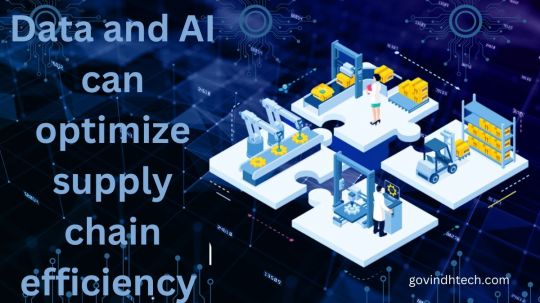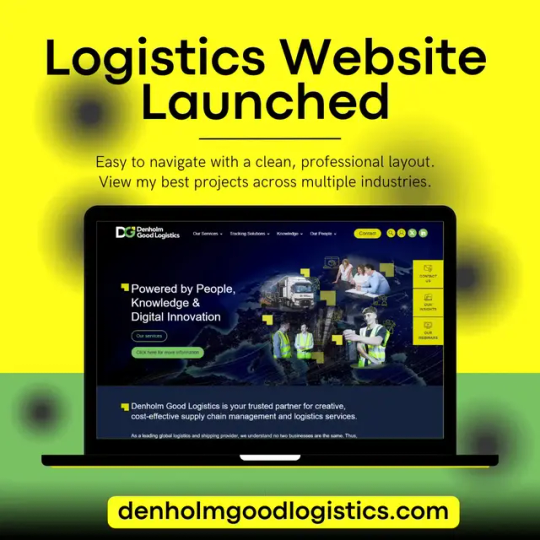#SupplyChain Optimization
Explore tagged Tumblr posts
Text
Enhancing Efficiency: ERP Solutions for Gold & Jewellery Businesses by Sigzen
In the dynamic realm of gold and jewellery businesses, precision and efficiency are indispensable. From sourcing raw materials to delivering exquisite pieces, every step requires seamless coordination and meticulous management. Enter ERPNext – a light of modern efficiency, offering tailored solutions to empower businesses in the gold and jewellery industry. As an expert in ERPNext with real-time…

View On WordPress
#Business Intelligence#Cost Reduction#Efficiency Optimization#ERP Solutions#Goldjewellery Business#Inventory Management#Production Planning#SupplyChain Optimization#Workflow Efficiency
3 notes
·
View notes
Text
1 note
·
View note
Text
0 notes
Text

Integrating AI into the supply chain isn’t just an upgrade—it’s a game-changer.
AI enhances supply chains with better forecasting, automation, and efficiency, reducing costs and delays. Embrace AI to stay ahead in a dynamic market.
Discover how AI can revolutionize your supply chain processes at https://bit.ly/3XqRBd1
#SupplyChain#AI#Efficiency#Optimization#Logistics#BusinessGrowth#SupplyChainInnovation#SmartSupplyChain#AIinBusiness#LogisticsTech#DigitalTransformation#AIOptimization#SupplyChainSolutions#AIandAutomation#FutureOfSupplyChain#TechInLogistics
0 notes
Text
Demand Planning: Moving Beyond Basic ML Models with Shock Resilient AI Decisioning Agents
In the rapidly evolving landscape of business analytics, demand forecasting stands as a critical pillar for manufacturers across FMCG industries. Accurate predictions of customer demand enable businesses to optimize inventory management, production schedules, and resource allocation, ultimately driving efficiency and profitability. However, as many organizations have experienced, maintaining the accuracy of demand forecasting models can be a persistent challenge, especially with basic machine learning (ML) approaches that lack resilience to shocks and unforeseen events.
In recent years, the shortcomings of conventional ML models in handling sudden disruptions and maintaining accuracy over time have become increasingly apparent. Factors such as commodity spikes, new trade constraints and complexities, market fluctuations, consumer spend (Personal Consumption Expenditures), and unexpected events like supply chain disruptions or global geopolitical crises can quickly render traditional forecasting models obsolete, leading to costly errors and missed opportunities.
DeepVu is at the forefront of addressing these challenges with our VuDecide product, with its innovative Shock Resilient Decisioning Agents. These AI Agents represent a paradigm shift in demand planning, leveraging advanced AI techniques to adapt dynamically to changing conditions, recommending actions that optimize directly for your KPIs maintaining# accuracy in the face of uncertainty.
So, what can businesses do when their demand forecasting models start fading in accuracy? Here are some key considerations:
Evaluate Current Model Performance: Before making any changes, it's essential to assess the performance of existing forecasting models. Identify where and why inaccuracies are occurring, whether due to data quality issues, model limitations, or external factors.
Explore Advanced AI Solutions: Basic ML models may struggle to cope with the complexity and volatility of real-world demand dynamics. Exploring advanced AI solutions like DeepVu's Shock Resilient Decisioning Agents can provide a more robust framework for demand forecasting, capable of adapting in real-time to changing conditions and outlier events.
Integrate External Data Sources: Enhance the accuracy and robustness of forecasting models by incorporating a diverse range of external data sources. We call this VuGraph an expansive and continuously growing supply chain knowledge graph. This includes macroeconomic indicators (interest rates, treasury yields, unemployment rates, wages etc), commodity prices, production volumes, PPI (producer price index), weather data, or industry reports, providing valuable context and insights for more informed decision making.
Implement Continuous Learning: Static models quickly become outdated in today's dynamic business environment. Implementing mechanisms for continuous learning and model refinement ensures that forecasting algorithms remain adaptive and responsive to evolving patterns and trends.
Invest in Resilience and Flexibility: Recognize the importance of resilience and flexibility in demand forecasting. By investing in technologies like DeepVu's Shock Resilient Decisioning Agents, businesses can build a more agile and responsive forecasting infrastructure capable of withstanding shocks and disruptions.
Monitor and Iterate: Continuous monitoring and iterative refinement are essential for maintaining the relevance and effectiveness of demand forecasting models over time. Regularly evaluate model performance, solicit feedback from end-users, and iterate on improvements to ensure ongoing alignment with business objectives.
In conclusion, the challenge of maintaining accuracy in demand forecasting/planning models is a pervasive issue faced by many enterprises today. While traditional ML approaches may struggle to adapt to changing conditions and unforeseen events, innovative solutions like DeepVu's Shock Resilient AI Decisioning Agents offer a promising path forward. By embracing advanced AI techniques, integrating diverse data sources from a rich industry specific knowledge graph, and fostering a culture of continuous learning and collaboration, businesses can enhance the resilience and effectiveness of their demand planning efforts, driving better decision-making and sustainable growth in an increasingly dynamic marketplace.
0 notes
Text
youtube
#SAPPPDS#ProductionPlanning#DetailedScheduling#Manufacturing#SupplyChain#SAPSCM#Optimization#CapacityPlanning#DemandMana#Youtube
0 notes
Text
How to Gain a Competitive Advantage with 3PL Logistics Software

In today's fiercely competitive business landscape, organizations are constantly seeking innovative ways to gain an edge over their rivals. One increasingly popular strategy is the strategic implementation of third-party logistics (3PL) software. This article aims to provide valuable insights into how companies can leverage 3PL logistics software to achieve heightened efficiency, substantial cost savings, and ultimately improved customer satisfaction. By streamlining operations and optimizing supply chain management, businesses can unlock a myriad of benefits that propel them ahead of their competition ...read more
#logistics solutions#logistics#logistics software#supply chain#supplychain#supplychainmanagement#supplychainsolutions#supply chain optimization#warehousing#warehouse
0 notes
Text
Data and AI can optimize supply chain efficiency

Every sector is undergoing a data and AI-driven revolution, including the supply chain that underpins many of those sectors. In recent years, supply chains have become more visible to corporations, as well as having a greater impact on the lives of customers. At the same time, the difficulties of meeting sustainability demands while maintaining a balance between geopolitical and financial issues have made it more difficult than it has ever been to manage supply chains in a way that is both efficient and sustainable.
Through the use of data and AI, Google Cloud has been able to bring excellent results to its supply chain customers. These customers have been given the opportunity to better understand their supply chains, locate areas in which they can improve, achieve their sustainability goals, and make decisions that are more informed.
Today, we are delighted to introduce our years of industry experience to a wider range of customers by offering them access to our Data and AI Cloud for Supply Chain solution. Building data-driven supply chains using our technology and value accelerators has proven to be extremely valuable for our customers, who have helped us acquire a profound understanding of a wide range of business sectors along with our business partners and customers. The following are some of the advantages that come along with using Data and AI Cloud for Supply Chain:
You may provide exceptional client experiences by utilizing data and AI to get a better knowledge, boost the efficiency of your supply chain, and increase its resistance to disruption. Make an accurate forecast of when products will be needed and figure out the best time- and cost-effective strategy to get them to the desired location.
The ability of enterprises to identify bottlenecks, inefficiencies, and hazards through increased visibility has enabled them to free up resources, automate wherever it is practicable, and boost efficiency, leading to a reduction in both costs and their carbon footprint. This has been abundantly obvious not just via the decreased costs, but also through the increased happiness of both customers and employees.
A platform designed to expedite the deployment of AI-enabled use cases: Be prepared to utilize the most recent advances in generative AI technology for intercompany search, for instance, to gain insights into the far ends of the supply chain by asking a simple inquiry; or to serve up individualized experiences to your customers based on the availability of real-time inventory.
Providing value for the benefit of our customers
For a number of years now, innovative businesses have been reaping the benefits of employing Google’s Data and AI Cloud to power their operations.
Coop : By forecasting with the use of Google’s Data and AI technologies, Coop is able to cut down on the amount of food that is wasted, which results in a 43% performance gain over the solution that was built in-house specifically for their needs.
Renault enhances the visibility of its supply chain, lowers the cost of its inventory, gains a better understanding of the components’ end-of-life, and controls its logistics operations more effectively, all of which contribute to an increase in customer satisfaction.
Capabilities offered by Google’s Data and AI Cloud for the Supply Chain
The Data and AI Cloud for Supply Chain from Google features a wide selection of solutions and value accelerators that are designed to assist organizations in improving the efficiency of their supply chains. The following are some of the most important solutions and value accelerators:
AI-optimized planning and forecasting: The technologies offered by Google Cloud and our partners give companies the option to employ machine learning to help optimize their planning and forecasting procedures, as well as the availability of their products on store shelves. They could be able to cut waste as a result of this, as well as improve customer service and raise earnings.
Vendor performance visibility: Visibility into the performance of vendors is provided by this service, which assists businesses in monitoring the performance of their suppliers. This information can be used to identify and address possible issues, such as late deliveries or products of low quality, and it can also be utilized to prevent such issues from occurring.
Sharing data between companies: Companies may now more readily share data with their partners, vendors, and customers across their supply chain. This helps improve collaboration and coordination, and it also assists companies in making more informed decisions. Businesses are able to increase their collaboration and coordination, as well as make better informed decisions, by securely sharing data with their trading partners and connecting to a variety of data sources provided by our expansive ecosystem of suppliers.
Sophisticated partner ecosystem: We collaborate with a wide variety of Independent Software Vendors (ISVs) in the areas of supply chain and sustainability as part of our sophisticated partner ecosystem. Integrating third-party software applications (ISVs) like Kinaxis, Dematic, Atlas AI, ESG Book, NGIS, Project44, and Geotab into Google Cloud’s data and artificial intelligence capabilities helps our customers with crucial workflows. Utilizing the most recent iteration of Google Cloud’s Industry Value Networks, which brings accelerators and reusable intellectual property and assets together with select partners to solve a variety of high-value use cases across sectors, can further speed the development path of an organization.
Enhance and speed up the potential available in your supply chain
Using data and artificial intelligence, organizations of all sizes can improve the efficiency of their supply chains with the assistance of Google’s Data and AI Cloud for Supply Chain, which is a robust collection of solutions, value accelerators, and partner offers. Listen to our presentation at Google Cloud Next or get in touch with us through this page to find out more.
News source:
https://govindhtech.com/data-and-ai-can-optimize-supply-chain-efficiency/
0 notes
Photo

🚚✨ How is AI transforming the logistics industry? 📦🤖 From optimizing routes to improving supply chain efficiency, AI is unlocking new business opportunities while tackling key challenges. Discover how artificial intelligence is reshaping the future of logistics and driving growth for businesses worldwide. 🌐🚀 Stay ahead of the curve and learn about the latest AI-driven trends in logistics today! Read more here 👉 https://bit.ly/4eLr4gd #Logistics #AI #SupplyChain #TechInnovation #Appicial #BusinessGrowth #AIinLogistics #FutureOfLogistics #LogisticsApp #OnDemandDelivery #mobileappdevelopment #logistic #transportation #OnDemandLogistics #AppDevelopment #TransportationServices #MobileApps #LogisticsIndustry #uberforlogistics #dronedeliveryapp
1 note
·
View note
Text
#sciencefather |🔍 Differential Game Model of Fresh Supply Chain 🥬📦#SupplyChain #DifferentialGame
🏆 International Research Awards on Strategic Management & Business Strategy 🌍📈
In this video, we dive into a cutting-edge differential game model designed for fresh supply chains 🍓🥦. Discover how preservation strategies, behavioral decisions of supply chain members, and government subsidies interact to optimize supply chain performance. 📌 Key Topics Covered: ✅ Dynamic modeling of fresh product supply chains ✅ Role of preservation investment 🧊 ✅ Strategic decision-making of suppliers & retailers 🤝 ✅ Impact of government support & subsidies 🏅💵 ✅ Sustainable and efficient operations 🌱🚛 This research-based model offers valuable insights for academics, policymakers, and supply chain managers aiming to enhance fresh product quality, reduce waste, and promote collaborative practices in the agri-food sector.
visit : https://business-strategy-conferences.scifat.com/ Nomination link : https://business-strategy-conferences.scifat.com/award-nomination/?ecategory=Awards&rcategory=Awardee Registration link: https://business-strategy-conferences.scifat.com
📚 Based on advanced game theory and control models. 👍 Like, 💬 Comment, and 🔔 Subscribe for more research insights! 🎯 Celebrating excellence in: 📚 Academic Research 💼 Business Innovation 📊 Strategic Decision-Making 🌐 Global Management Practices 🏅 Honoring top minds in: 🔍 Strategic Planning 🚀 Competitive Advantage 🧠 Organizational Behavior 📘 Corporate Governance 🤝 Leadership & Collaboration Join the global conversation and witness how research shapes the future of business strategy and management science!
#🌟#ResearchAwards 🥇#BusinessStrategy 📈#StrategicManagement 🧭#Innovation 🌟#Leadership 💼#GlobalImpact 🌍#SupplyChain#DifferentialGame#FreshProducts#GameTheory#Sustainability#GovernmentSubsidies#Research#Preservation#Agribusiness#OperationsResearch
0 notes
Text
📊 Enhance Inventory Control with the Kogan Seller #ProductDataScraping API

Staying ahead in the fast-paced world of eCommerce requires more than just great products—it demands real-time insights into your marketplace performance. The #KoganSellerProductDataScrapingAPI empowers businesses to access granular product-level information, enabling smarter #inventorymanagement and operational efficiency.
With this API, you can:
✅ Monitor #competitorpricing and stock levels ✅ Track #productlistings and availability trends ✅ Optimize #supplychain planning based on real-time demand ✅ Eliminate stockouts and reduce overstock with #predictiveanalytics ✅ Improve #ProductLifecycle management with data-backed decisions
Whether you’re a brand, seller, or aggregator, leveraging #webscraping on Kogan’s platform means tapping into a powerful source of #ecommerceintelligence to strengthen your market position.
0 notes
Video
youtube
Decoding Technical Translation: Lessons from Avantor’s SAP Upgrade and Batch Numbering Overhaul
Yo, when a big dog like Avantor, a materials science G.O.A.T., upgrades its SAP system and messes with batch numbers, it ain't just an IT thing, ya dig? It's a masterclass in tech comms and translation finesse. As a translator, breakin' down these docs gives you the keys to unlock language barriers while keepin' the tech stuff tight. Let's get into how to handle terminology, coding, and formatting to make sure everyone's on the same page, globally.
1. Terminology: The Art of Industry-Specific Localization Case Study:
Original Term: Certificates of Analysis
Literal Translation: "Analysis Certificates" (❌ Sounds sus in regulated industries)
Optimized Translation: "Certificates of Analysis" (✔️ Keep it for compliance) or "Test Reports" (depends on the context).
Key Insight: In places like pharma, where the rules are strict, you gotta stick to standards like ICH or GMP. Mess up and translate "Qualified Person" as "Certified Individual" (instead of "QP" or "质量受权人" in Chinese)? You're askin' for trouble.
Strategies:
Build glossaries with tools like SDL Trados, puttin' the client's terms first.
Check against industry standards (ISO, FDA) to make sure you're right.
Use AI with caution—GPT-4 drafts need a human touch to get the meaning right.
2. Encoding Logic: Turnin' Code into Clarity Avantor’s Batch Number Format: YYMDD@XXX
Breakdown:
YY: Year (e.g., 21 = 2021)
M: Month code (A=Jan, J=Oct, L=Dec)
DD: Day
@@: Plant code (61=Paris, KY; 62=Phillipsburg, NJ)
XXX: Sequential counter
Translation Challenges:
Symbol Retention: Keep the symbols (like @@, XXX) so things don't get confusing.
Visual Aids: Use tables to show the letter-month codes (see Fig. 1) and explain the weird stuff (like "L=December").
Example Localization:
Original: "21J0661001" → Translated explanation: "2021-Oct-06, Paris Plant (61), Batch 001."
3. Formatting: The Silent Ambassador of Professionalism Common Pitfalls & Solutions:
Tables all messed up: A broken "Tech nical.Service" in contacts looks amateur.
Fix: Use Markdown/LaTeX for alignment; check with tools like Adobe Acrobat.
Punctuation all over the place: Mixed EN/CN commas mess up the flow.
Fix: Use AI tools (e.g., iThenticate) to catch it automatically.
Three-Step Quality Assurance:
Content Layer: Check dates, codes, and contacts against the original.
Logic Layer: Make sure the tech stuff makes sense (like plant codes match locations).
User Experience Layer: Make it easy to read—bold key terms, break up complex rules.
4. The Translator’s Toolkit for Technical Documents Terminology Management: SDL Trados, memoQ
Encoding Validation: Regex101, Notepad++
Formatting: Pandoc (multi-format conversion), Grammarly (punctuation consistency)
5. Why Human Translators Still Matter in the AI Era AI can get you started, but you still need a human for:
Contextual Judgment: Knowin' when to keep terms or translate them (like "SAP system" usually doesn't need translation).
Risk Mitigation: Catching small errors like "tracking" vs. "traceability."
Cultural Nuance: Adjusting examples (like explaining "Paris, KY" to people who ain't from the U.S.).
Engage & Learn 🗨️ Discussion Prompt:
What's the hardest tech document you've translated, and how'd you make sure it was right?
How do you balance AI speed with human accuracy in your work?
Visual Appendix
Fig. 1: Letter-Month Code Table (A=Jan, J=Oct, L=Dec)
Fig. 2: SAP Workflow Diagram (Pre- vs. Post-Upgrade)
Hashtags: #TechnicalTranslation #Localization #SupplyChain #SAP #Pharmaceuticals #Compliance
Tech translation ain't just about words—it's about connectin' systems, cultures, and rules. In this global game, gettin' it right ain't optional; it's how you survive.
0 notes
Text
Ports, cranes & salty air: Marine port services market is sailing toward $5.9B ⚓🚢
Marine Port Services Market is projected to grow from $3.2 billion in 2024 to $5.9 billion by 2034, registering a CAGR of 6.3%. This dynamic market covers a range of critical services like cargo handling, warehousing, vessel traffic management, and customs clearance. As global trade intensifies, ports remain vital to the efficiency of international supply chains, prompting investments in smart infrastructure and sustainable technologies. Container handling leads the market, accounting for 45% of total operations due to the surge in containerized goods. Bulk cargo services follow with 30%, driven by steady demand for raw materials and commodities. The ship repair and maintenance segment is also on the rise, reflecting the growing focus on fleet uptime and operational reliability.
To Request Sample Report : https://www.globalinsightservices.com/request-sample/?id=GIS21972 &utm_source=SnehaPatil&utm_medium=Article
Asia-Pacific dominates the market, fueled by strategic trade hubs in China and India. Europe ranks second, investing heavily in modernization to manage growing cargo volumes. North America, though smaller in scale, is evolving quickly with tech-driven port optimization.
#marineports #portservices #globaltrade #cargohandling #containerterminals #bulkcargo #liquidcargo #shiprepair #maritimelogistics #portinfrastructure #dpworld #psainternational #hutchisonports #shippingindustry #iotinports #blockchainlogistics #smartports #portsecurity #vesselmanagement #supplychain #customsclearance #portmodernization #warehousing #dockoperations #loadingequipment #towageservices #pilotageservices #mooring #bunkering #cranesystems #cloudbasedsolutions #asiamaritime #europeanports #northamericaports #portautomation #sustainableports
Research Scope:
· Estimates and forecast the overall market size for the total market, across type, application, and region
· Detailed information and key takeaways on qualitative and quantitative trends, dynamics, business framework, competitive landscape, and company profiling
· Identify factors influencing market growth and challenges, opportunities, drivers, and restraints
· Identify factors that could limit company participation in identified international markets to help properly calibrate market share expectations and growth rates
· Trace and evaluate key development strategies like acquisitions, product launches, mergers, collaborations, business expansions, agreements, partnerships, and R&D activities
About Us:
Global Insight Services (GIS) is a leading multi-industry market research firm headquartered in Delaware, US. We are committed to providing our clients with highest quality data, analysis, and tools to meet all their market research needs. With GIS, you can be assured of the quality of the deliverables, robust & transparent research methodology, and superior service.
Contact Us:
Global Insight Services LLC 16192, Coastal Highway, Lewes DE 19958 E-mail: [email protected] Phone: +1–833–761–1700 Website: https://www.globalinsightservices.com/
0 notes
Text
Navigating Uncharted Waters: Why Simulating Shock Scenarios Is Critical in Resilient Supply Chain Planning
In an ever-evolving global landscape, the art of supply chain planning has transcended mere forecasting. It's about foreseeing the unexpected, anticipating disruptions, and steering through the uncharted waters of economic uncertainties and geopolitical turbulences.
Consider this: as we navigate the complex web of global commerce, shock scenarios such as an expected recession/slowdown or geopolitical conflicts can cause ripples felt throughout supply chains. Recent geopolitical upheavals, record inflation in some countries, and an expected global economic downturns have starkly underscored the significance of preparing for the unforeseen.
Simulating shock scenarios, including economic downturns or geopolitical unrest, isn't merely a hypothetical exercise. It's a proactive strategy that can fortify supply chains against unforeseen disruptions. Here's why it matters:
1. Anticipating and Simulating Economic Fluctuations: With the global economy in a state of flux, simulating scenarios like a looming recession or growth slowdown in the USA isn't just prudent; it's essential. So, it's true the US economy is still growing strong as of this month, and the recession camp has been shifting it forward for a while now, so what's a planner to do? Can your company really afford to wait until macro economists declare it a recession! How about no recession just a drop form 4.9% YoY growth to 2%-- that's not technically a recession, but it surely will dent your revenue!
Predictive analytics can offer insights, but simulating these scenarios goes beyond prediction, empowering supply chain planning executives to proactively strategize for resilience.

2. Mitigating Geopolitical Risks: Recent geopolitical tensions and conflicts can significantly impact commodities, transportation routes, and international trade. By simulating the impact of such events, supply chain planners can identify vulnerabilities and devise contingency plans to mitigate risks.

Image: Ukraine's wheat being loaded onto cargo vessel. Src: Global Trade Review.
3. Importance of Resilience: Supply chains built solely on forecasts are fragile. Resilient supply chains, on the other hand, thrive amidst uncertainties. Simulating shock scenarios allows for the cultivation of robust, adaptable supply chain strategies that can weather the storm, ensuring continuity even in turbulent times.
4. Agility in Decision-Making: By envisioning and preparing for shock scenarios, supply chain planners gain agility in decision-making. They're equipped to swiftly adapt and implement decisioning that optimize directly for their business KPIs when faced with unforeseen disruptions, thereby minimizing the impact on operations.
At DeepVu, we recognize the transformative power of simulating shock scenarios. Our AI Decisioning Agents empowers supply chain planners with autonomous, resilient decision-making tools that thrive on adaptability, not just predictions. Our aim is not just to predict disruptions but to prepare your supply chain to navigate and emerge stronger from them.
In the dynamic realm of supply chain management, it's not merely about surviving disruptions; it's about thriving despite them. Let's not just predict the future; let's shape it, together.
Join us in reimagining supply chain resilient planning. #autonomousResilientPlanning
1 note
·
View note
Text

🚀 Exciting News! I just launched a brand-new logistics website, designed for seamless shipping, tracking, and delivery management! The site is user-friendly, fast, and optimized for efficiency.
Check it out now! 🌍📦 https://denholmgoodlogistics.com/
#Logistics #NewWebsite #FreightSolutions #SupplyChain #Shipping #TechInnovation #BusinessGrowth
0 notes